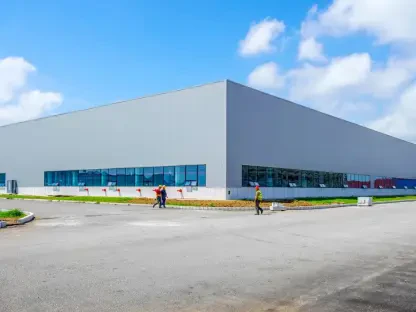The subject of demand and inventory management within the supply chain has never been more critical, especially as global disruptions continue to challenge conventional strategies. Saul Resnick, CEO UK&I at DHL Supply Chain, along with experts from Proxima and HFS Research, share their insights into the modern approaches required to navigate today’s volatile supply chain environment. Finding the right balance in managing inventory and meeting demand is not just about maintaining efficiency but about building resilience against unforeseen disruptions.
Significance of Demand and Inventory Management Post-Pandemic
The Impact of COVID-19 on Supply Chains
The COVID-19 pandemic was a defining moment for supply chains, bringing to light the cracks in traditional just-in-time (JIT) inventory systems. Widely respected for its ability to minimize capital expenditure and enhance cash flow, JIT’s dependence on low buffer stock proved ineffective when global manufacturing and logistical networks were abruptly curtailed. The pandemic caused a domino effect, where delays and shortages at one end of the supply chain rippled through to the end consumer, revealing the fragility of these tightly tuned systems. Businesses, therefore, found themselves rethinking their entire supply chain strategies, searching for solutions that would provide a safety net against similar future shocks.
As businesses pivoted to respond to ongoing disruptions, resilience emerged as a pivotal focal point in supply chain management. Firms began to explore alternative sourcing strategies, more secure storage options, diversified transit routes, and innovative delivery mechanisms to create a more robust supply chain architecture. The lessons learned from COVID-19 have catalyzed a shift in industry paradigms, moving away from the lean inventories of JIT towards more flexible and buffered systems designed to withstand future disruptions.
Transition from JIT to JIC Models
John Carter of Proxima highlights that although conditions have somewhat stabilized since the peak of the pandemic, the industry continues to confront significant challenges. The critical question now confronting businesses is ‘what now?’ This uncertainty has led to a strategic shift from JIT to a just-in-case (JIC) inventory model. Unlike JIT, JIC emphasizes maintaining larger buffer stocks to guard against unpredictable disruptions. The shift to JIC was necessary during the pandemic but has retained its relevance as companies recognize its role in safeguarding against future crises that could potentially be even more disruptive than COVID-19.
The transition to JIC raises its own set of challenges and considerations. While it enhances resilience, it also increases costs related to storage and inventory holding. Businesses now have to find a delicate balance between cost efficiency and risk management. The key lies in optimizing inventory levels to ensure there is enough buffer stock to handle disruptions while avoiding excessive inventory that can strain financial resources. This new approach necessitates a more dynamic and responsive supply chain strategy, one that can adapt quickly to changes without losing sight of the overall operational and financial goals.
Current Inventory Management Challenges
Seasonal Stock and Storage Issues
Recent disruptions have fundamentally altered the timing and flow of seasonal stocks, bringing them to markets earlier than usual. Saul Resnick underscores that businesses are now compelled to find additional storage space, often on short notice, to accommodate these early arrivals. The UK’s experience this past season has further complicated matters with an overabundance of summer inventory, largely attributed to an underperforming summer season. This excess has left businesses grappling with the financial burdens of storing these unsold goods or facing the difficult decision to discount or offload these items to make room for the upcoming seasonal inventory.
The management of surplus seasonal stock presents both operational and financial challenges. Holding onto these excess inventories incurs additional storage costs, and with warehousing space at a premium, the financial implications can be significant. Alternatively, discounting or liquidating surplus stock can result in substantial revenue losses and potentially damage brand equity. Therefore, businesses must carefully navigate these choices, balancing the cost implications with the need to maintain sufficient storage capacity for new inventory. This complex scenario highlights the intricate nature of inventory management and the critical need for strategic planning and adaptability.
Sourcing and Supply Chain Agility
Despite ongoing disruptions, the anticipated shift to nearshoring has yet to take full effect, particularly in the UK and Europe. Instead, businesses continue to rely heavily on sourcing from East Asia, driven by established supply chain networks and cost considerations. The focus has thus shifted towards enhancing supply chain agility—crafting systems that can respond swiftly to changing conditions and challenges. The demand for agile supply chains underscores the growing complexity and interconnectedness of global trade, where the ability to pivot and adapt quickly can determine a company’s success in an unpredictable market environment.
Creating agile supply chains involves rethinking traditional models and implementing strategies that allow for greater flexibility and responsiveness. This may include diversifying suppliers, investing in technology to enhance visibility and control, and developing contingency plans to address potential disruptions. The challenge lies in balancing the goals of operational efficiency and cost control with the need for resilience and adaptability. For supply chain managers, this means continuously evaluating and adjusting strategies to ensure that the supply chain can meet both current operational needs and future uncertainties.
Forecasting and Integration Challenges
Complexity of Demand Forecasting
Accurate demand forecasting has always been a challenge, made even more complex by the rapidly evolving consumer and corporate purchasing behaviors observed in recent times. The unpredictability of these patterns necessitates a more dynamic and responsive approach from supply chain teams. Traditional forecasting methods, which rely heavily on historical data, are increasingly insufficient in capturing the nuances of modern demand trends. Therefore, businesses are turning to more sophisticated tools and methodologies to anticipate and respond to these shifts effectively.
Incorporating real-time data and advanced analytics into forecasting processes can significantly enhance accuracy and responsiveness. This includes leveraging data from various sources such as consumer feedback, market trends, and economic indicators to build a comprehensive understanding of demand patterns. Furthermore, increasing integration within supply chain functions is viewed as a crucial step towards achieving more efficient demand and inventory management. Ashish Chaturvedi emphasizes the potential of collaborative and autonomous supply chains, which could reduce human dependency and provide greater visibility across all functions, fostering comprehensive integration and more accurate demand forecasting.
Benefits of Integrated Systems
Saul Resnick supports the integration of demand and inventory systems with broader supply chain management, highlighting the benefits of end-to-end visibility. This integration can transform operations, enabling businesses to make proactive and informed decisions based on precise data regarding capacity, demand, and inventory levels. For DHL, leveraging digital solutions through their advanced warehouse management systems has been fundamental in maintaining consistently accurate inventory levels. These systems facilitate precise delivery assessments and enhance forecasting accuracy, ultimately improving operational efficiency and customer satisfaction.
Integrated systems offer several benefits beyond visibility. They streamline communication and coordination across different supply chain functions, reducing the likelihood of misalignment or delays. By providing a single source of truth, these systems ensure that all stakeholders have access to the same information, promoting better collaboration and decision-making. The integration also supports scalability, allowing businesses to expand or adjust operations in response to changing demand or market conditions without compromising efficiency. As companies continue to invest in these advanced systems, the potential for significant improvements in demand and inventory management becomes increasingly evident.
Technological Advances in Supply Chain Management
Role of AI and Machine Learning
AI and machine learning (ML) have started to play a transformative role in demand and inventory management. However, John Carter notes that the terms AI and ML are often used broadly to describe established algorithmic analytics. The genuine innovation lies in the application of large language models (LLMs) capable of understanding and generating translations, summarizing texts, and answering complex questions. These models can analyze vast amounts of data from diverse sources, such as social media, news, and customer feedback, to gauge sentiment and predict future demand. This capability equips supply chain teams with actionable insights, enabling them to make data-driven decisions and stay ahead of market trends.
The introduction of these advanced AI tools into supply chain management holds the potential to revolutionize the industry. By offering real-time analysis and predictive capabilities, LLMs can help businesses anticipate changes in demand, optimize inventory levels, and reduce the risk of stockouts or overstocking. These models also enhance supply chain resilience by identifying potential disruptions and recommending mitigation strategies. As AI and ML technologies continue to evolve, their integration into supply chain processes will likely become even more sophisticated, driving further improvements in efficiency and accuracy.
Transformative Potential of AI Tools
John underscores that AI tools capable of delivering knowledgeable responses to any supply chain-related query could be truly transformative. These tools can act as personal analysts and advisors, providing businesses with the information they need to make informed decisions quickly and accurately. By leveraging AI in this manner, companies can enhance their strategic planning and operational execution, gaining a competitive edge in the market. Such advancements are particularly relevant in retail and other value chains where timely and accurate information is crucial for success.
The transformative potential of AI extends beyond just answering queries. These tools can also automate routine tasks, reducing the need for manual intervention and freeing up human resources to focus on more strategic activities. For instance, AI can handle tasks such as demand forecasting, inventory optimization, and order fulfillment with greater accuracy and speed than traditional methods. This not only improves operational efficiency but also enhances overall supply chain performance. As AI technology continues to advance, its applications within the supply chain will expand, offering new opportunities for innovation and efficiency.
Automation’s Role and Future Prospects
Enhancing Efficiency with Automation
Automation is key to realizing the vision of an autonomous supply chain, reducing human dependency, and increasing efficiency. Ashish Chaturvedi predicts that object-centric process mining will replace traditional case-centric methods, thereby improving visibility and cycle times for critical activities like the S2P (Source-to-Pay) cycles. This improvement is expected to pave the way for autonomous factories, warehouses, and fulfillment vehicles. By optimizing inventory movement and reducing process cycle times, automation can significantly enhance supply chain performance and resilience.
The transition to more automated processes involves a strategic investment in technology and infrastructure. However, the long-term benefits, including reduced labor costs, improved accuracy, and faster processing times, can outweigh the initial expenditure. Automation can also help address labor shortages and meet the growing demands of e-commerce by ensuring faster and more reliable fulfillment. As businesses integrate automation into their supply chains, they can achieve a level of operational efficiency and agility that is critical in today’s fast-paced market environment.
DHL’s Digitalization and Robotics Integration
Demand and inventory management within the supply chain is an increasingly critical topic, especially as global disruptions continue to challenge standard strategies. Saul Resnick, CEO UK&I at DHL Supply Chain, alongside specialists from Proxima and HFS Research, offer valuable insights into the contemporary methods necessary to navigate today’s unpredictable supply chain landscape.
The importance of striking the right balance between managing inventory and meeting demand goes beyond mere efficiency. It’s also about developing resilience to withstand unexpected disruptions. In an ever-changing global market, traditional strategies often fall short, necessitating innovative approaches to keep supply chains robust and adaptable.
Resnick emphasizes that modern supply chain management must integrate flexibility and anticipation of potential issues to ensure continuity. Experts from Proxima and HFS Research concur, highlighting the need for comprehensive planning and real-time responsiveness. They argue that technology plays a vital role, with advanced analytics and automation providing the tools required to predict trends and adapt swiftly to changes.
Given the volatile nature of the current environment, companies need to prioritize building stronger, more agile supply chains. It’s not just about surviving disruptions but thriving amid them by implementing cutting-edge solutions and staying ahead of the curve. The integration of resilient practices in inventory management is crucial for maintaining stability and ensuring long-term success in today’s dynamic global market.








